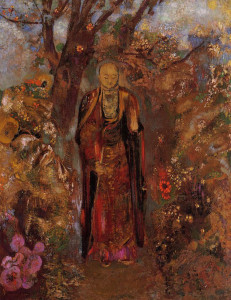© Bhikkhu Bodhi, The Middle Length Discourses of the Buddha (Wisdom Publications, 2009)
1.Thus have I heard. On one occasion the Blessed One was living at Sāvatthī in Jeta’s Grove, Anāthapiṇḍika’s Park.
2.Then, when it was morning, the Blessed One dressed, and taking his bowl and outer robe, went into Sāvatthī for alms. Then a number of bhikkhus went to the venerable Ānanda and said to him: “Friend Ānanda, it is long since we heard a talk on the Dhamma from the Blessed One’s own lips. It would be good if we could get to hear such a talk, friend Ānanda.”—“Then let the venerable ones go to the brahmin Rammaka’s hermitage. Perhaps you will get to hear a talk on the Dhamma from the Blessed One’s own lips.”—“Yes, friend,” they replied.
Familiar opening setting at Sāvatthī in Jeta’s Grove, Anāthapiṇḍika’s Park. This is the location in which Siddhattha Gotama presented most of his discourses.
Bhikkhus: monks. In most of these Pali discourses the Buddha is addressing the Original Ariyans—his group of monastic disciples. It is not surprising that it was in a monastic venue that the Deathless Dharma first took root, so divorced as it is from the usual malaise of mundane and aggregated existence. Indeed, the utmost deathless potentiality is only made certain through a perfection in wisdom that is unconcerned with habitual ties to the general angst of temporal communalities. Only in total and unhindered recollective-resolve is the source of the perfected deathlessness (Nibbatta) won.
Ānanda: the Buddha’s closest confidant and chief attendant in promulgating the Buddhadharma. Notice how he prepares the Bhikkhus for an audience with the Buddha by generating a sense of anticipation.
brahmin Rammaka’s hermitage: interesting how Rammaka himself doesn’t appear in the discourse, nor do any of his disciples. The importance of the location is highly symbolic of a detached setting, immersed in solitude, a virgin place whose very silence is rich and undefiled primordial soil from which the words of the Tathāgata (Bodhi-seeds) take root.
3.Then, when the Blessed One had wandered for alms in Sāvatthī and had returned from his almsround, after his meal he addressed the venerable Ānanda: “Ānanda, let us go to the Eastern Park, to the Palace of Migāra’s Mother, for the day’s abiding.”—“Yes, venerable sir,” the venerable Ānanda replied. Then the Blessed One went with the venerable Ānanda to the Eastern Park, the Palace of Migāra’s Mother, for the day’s abiding.
Palace of Migāra’s Mother:
“Upon hearing the Buddha preach, Migara became a stream-enterer (SROTAAPANNA), and remained forever grateful to Visakha, even giving her the sobriquet Migaramata, “Migara’s Mother.” Visakha fed five hundred monks in her home daily, and was constant in her attentions to the monastic community in Savatthi. She fulfilled a long-held wish when she had a grand monastery built to the east of the city named Migaramatupasada. [Buswell Jr., Robert E.; Donald S., Jr. Lopez (2013-11-24). The Princeton Dictionary of Buddhism (Kindle Locations 74157-74163). Princeton University Press. Kindle Edition.]”
Then, when it was evening, the Blessed One rose from meditation and addressed the venerable Ānanda: “Ānanda, let us go to the Eastern Bathing Place to bathe.”—“Yes, venerable sir,” the venerable Ānanda replied. Then the Blessed One went with the venerable Ānanda to the Eastern Bathing Place to bathe. When he was finished, he came up out of the water and stood in one robe drying his limbs. Then the venerable Ānanda said to the Blessed One: “Venerable sir, the brahmin Rammaka’s hermitage is nearby. That hermitage is agreeable and delightful. Venerable sir, it would be good if the Blessed One went there out of compassion.” The Blessed One consented in silence.
Eastern Bathing Place to bathe: Given the proper etiquette of the age, spiritual sojourners would often seek out locations providing rejuvenation in mind, body, and spirit, such as refreshing springs.
Notice how Ānanda doesn’t directly come out and ask the Buddha to appear before a preaching audience. It was only proper etiquette to invite the Blessed One to come to a place of spiritual refuge, and, if the ambience was appropriate, the spiritual discourses would commence.
The Blessed One consented in silence: Silence–a critical etiquette of the Buddha– a spiritually-normative and regal response. Yea, silence itself is a royal attribute of the Buddha and must never be ridiculed or downplayed and devalued as something insignificant.
4.Then the Blessed One went to the brahmin Rammaka’s hermitage. Now on that occasion a number of bhikkhus were sitting together in the hermitage discussing the Dhamma. The Blessed One stood outside the door waiting for their discussion to end. When he knew that it was over, he coughed and knocked, and the bhikkhus opened the door for him. The Blessed One entered, sat down on a seat made ready, and addressed the bhikkhus thus: “Bhikkhus, for what discussion are you sitting together here now? And what was your discussion that was interrupted?”
“Venerable sir, our discussion on the Dhamma that was interrupted was about the Blessed One himself. Then the Blessed One arrived.”
“Good, bhikkhus. It is fitting for you clansmen who have gone forth out of faith from the home life into homelessness to sit together to discuss the Dhamma. When you gather together, bhikkhus, you should do either of two things: hold discussion on the Dhamma or maintain noble silence.
Truly an auspicious event. The bhikkhus were just discussing the Dhamma as it related to the Buddha himself—and the Buddha appears in their midst.
The Blessed One makes it unequivocally clear that whenever the saṇgha is gathered, the brethren are called to focus exclusively on the Buddhadharma, or else maintain Noble Silence. Once again, the emphasis on silence as a profound spiritual attribute. There were even occasions when his disciples would just sit in silence and soak-up the Buddha’s sacred fragrance—yea, just being near him, in his blessed-presence, was enough.

